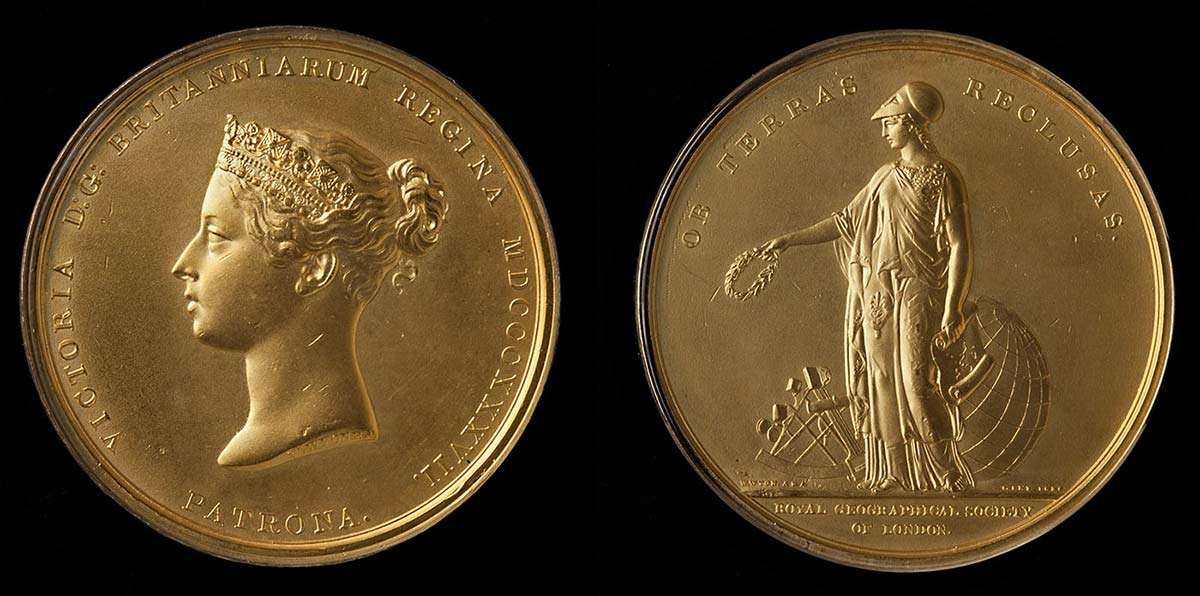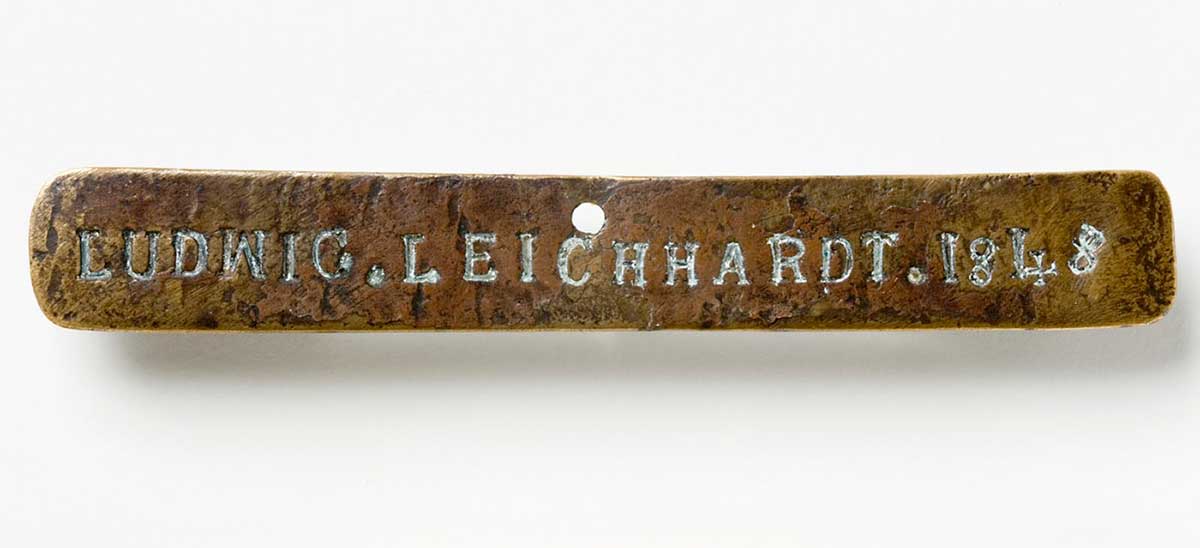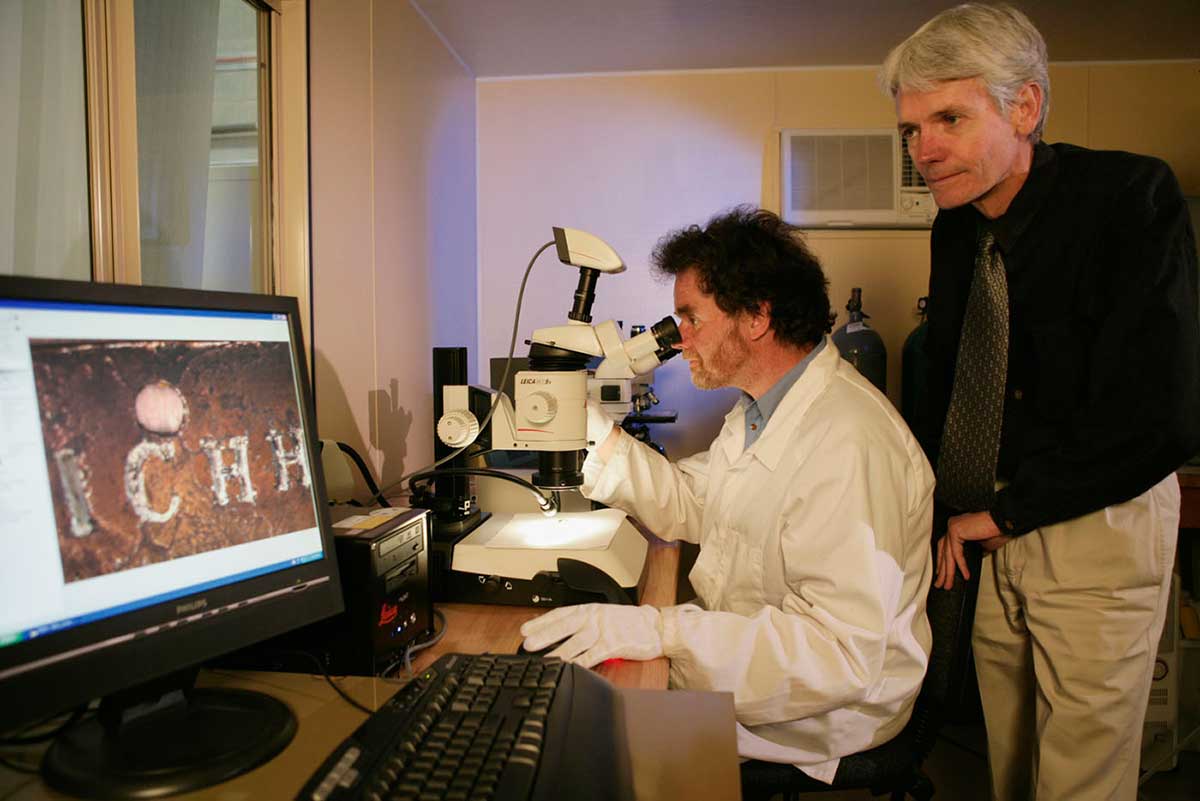The disappearance of Ludwig Leichhardt's third expedition in 1848 has been one of the great mysteries of Australian exploration. A small brass nameplate marked 'Ludwig Leichhardt 1848' is the first relic linked to the expedition that is supported by the historical record and scientific evidence.
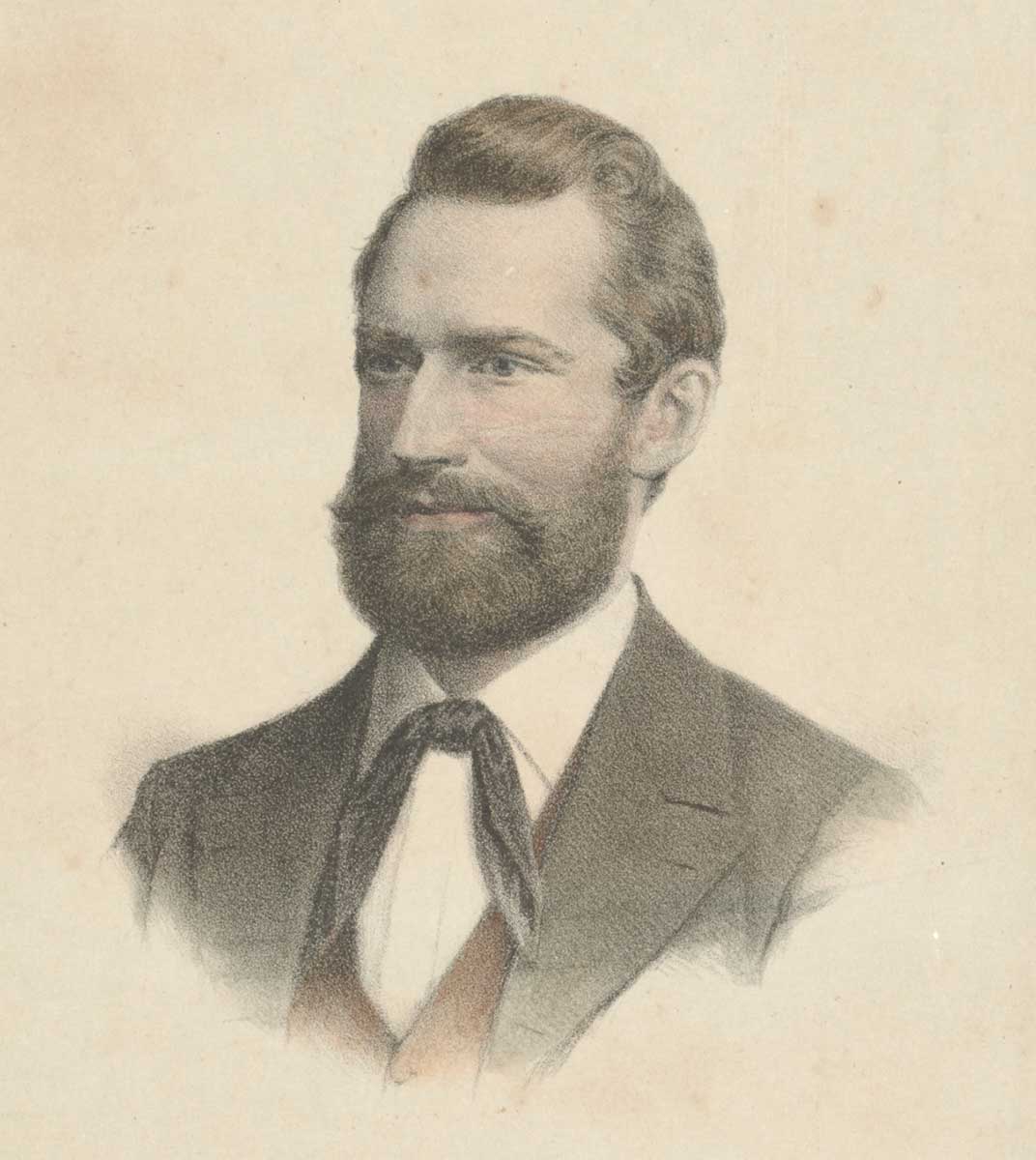
Leichhardt mystery
The German-born scientist and naturalist arrived in Sydney in 1842 and mounted three expeditions to explore Australia's inland.
The disappearance of Leichhardt's third expedition in 1848 and the failure to find any definite artefacts of the expedition has been one of the great mysteries of Australian exploration.
Many theories have been proposed over the years to explain where Leichhardt died, numbers of them concluding he perished somewhere near the Simpson Desert.
Leichhardt remains a household name in Australia, routinely a subject of primary school study. The mystery of the apparently total disappearance of his entire expedition party still has the power to compel curiosity, as investigations as recently as the 1990s demonstrate.
The expeditions of Leichhardt and Sir Thomas Mitchell opened up the northern interior for settlement and convinced pastoralists that there was viable grazing land.
The Leichhardt nameplate is the first relic with a corroborated provenance from the 1848 journey and it resolves substantial aspects of the mystery.
While the plate cannot tell us where Leichhardt died, it proves that he made it at least two-thirds of the way across the continent during his east–west crossing attempt. For a European to do this in 1848 represents a considerable achievement.
Discovery of the Leichhardt nameplate
The Leichhardt nameplate is a piece of brass 15cm x 2cm marked 'LUDWIG LEICHHARDT 1848'. It was discovered attached to a partly burnt firearm in a bottle tree (boab) near Sturt Creek, between the Tanami and Great Sandy Deserts, just inside Western Australia from the Northern Territory border.
Like a number of trees that have been identified elsewhere, and accepted as having been marked by Leichhardt on his fatal attempt to cross the continent in 1848, the boab tree was inscribed with an 'L'.
The Museum has a detailed history of the nameplate, from where it was found by an Aboriginal man in 1900, to its acquistion from the Bristow-Smith family in 2006. Both the historical record and scientific investigation support the conclusion that both the Leichhardt nameplate and its place of discovery are genuine.
Location of the nameplate
The burnt firearm with the nameplate was discovered around 1900 by an Aboriginal man, known as 'Jackie', who was working for an outback drover and prospector named Charles Harding. Harding disposed of the burnt firearm but recognised the plate as something important.
JF Hill, who also worked for Harding, remembered Harding having the plate. Harding kept it wrapped up and 'polished' it with ash from his fireplace whenever he got it out to show to someone. This care indicates that Harding believed in the plate's authenticity and value. Reginald Bristow-Smith (subsequently District Clerk at Laura, and later at Goolwa, South Australia) got to know Harding and, in about 1917–1918, Harding gave the plate to the then teenaged Bristow-Smith.
In 1920 Bristow-Smith loaned the plate to the South Australian Museum but declined the museum's request to donate the plate. In 1934 Bristow-Smith corresponded with surveyor and explorer LA Wells and loaned him the plate. Wells enabled JD Somerville, of the South Australian Branch of the Royal Geographical Society of Australasia, to begin an exhaustive investigation of the plate.
Somerville was particularly interested in identifying the place of the plate's discovery. Bristow-Smith readily provided information to Somerville during this project and Somerville published a paper in the Society's 1937 proceedings where he concluded that the plate was genuine.
The trail of the plate becomes somewhat confused in the late 1930s. LA Wells died in a rail accident in 1938, but the plate was in the possession JM Maughan who worked at the South Australian Lands Department. When Maughan died in the 1940s no-one in the South Australian bureaucracy knew who owned plate and it ended up with the Public Library of South Australia, which was administered by the Libraries Board of South Australia.
After lengthy correspondence, Bristow-Smith was finally able to get the plate returned to him in 1964. Bristow-Smith died several years later and the plate passed to his son Jeffery. Since Jeffery's death in 2004, the plate has been held by his wife Catherine and jointly owned by her and their four children. The National Museum of Australia acquired the nameplate from the Bristow-Smith family in 2006.
Proof that the nameplate is genuine
Both the historical record and scientific investigation support the conclusion that both the Leichhardt nameplate and its place of discovery are genuine.
Evidence from the historical record
- The behaviour of both Harding and Bristow-Smith is inconsistent with people who might have fabricated the plate for fraudulent purposes. Neither man sought rapid sale for profit or other reward, and Bristow-Smith was always ready to make the plate available for analysis and examination by experts who could have exposed a fraud.
- The nameplate correctly spells Leichhardt's name with the double 'h'. If it had been fabricated by Harding – a bushman with no formal education – it is unlikely the name would be correctly spelt. In fact Leichhardt's name was often spelt incorrectly with one 'h', and often still is.
- Leichhardt was methodical and systematic in his preparation for expeditions. He is known to have identified the equipment carried by the expedition, by marking it either with numbers or another system. Therefore a nameplate that identified Leichhardt's firearm is consistent with his usual behaviour. Equally plausible is the suggestion that the firearm (with plate) was a gift, perhaps from a station owner. Leichhardt was given a pair of pistols (with engraved initials of donor and recipient) before the expedition set out. The nameplate's rudimentary lettering is suggestive of it having been made by a station blacksmith prior to Leichhardt's departure from the settled districts.
- The tree in which the firearm was discovered was marked with an 'L'. This adds corroborative evidence to the presence of the Leichhardt expedition at the tree and to Leichhardt having placed the weapon in the tree, rather than Aborigines finding the firearm elsewhere or trading it, carrying it to the tree and placing it there.
- JD Somerville was told that the bottle tree was near Sturt Creek, near a Mt Inkerman, approximately a day's ride from the Musgrave Range, and within a certain distance of the Northern Territory – Western Australia border. Sturt Creek can be found on modern maps. Musgrave Range has erroneously been thought to be the South Australian range of that name. But there is a Western Australian Musgrave Range named by explorer PE Warburton in 1873. This range is south of Sturt Creek at Balgo. In addition, there is evidence that the Gardner Range (sometimes spelt Gardiner), closer to Sturt Creek, was also known by some as Musgrave. Mt Inkerman has been a source of confusion. 'Inkerman' is usually a name associated with the Crimean War. In the 1930s JD Somerville established it to be an Anglicisation of the Aboriginal name 'Inkermane' for a hill west of Mt Brophy near Sturt Creek and the Gardner Range.
- Finally, the area of the plate's discovery is consistent with the stated route of Leichhardt's third expedition. Dr Darrell Lewis has shown that Leichhardt planned to cross Australia from Moreton Bay to Swan River not via a direct east–west line (which would have taken him into desert country) but along an arc to the north along the headwaters of rivers flowing into the Gulf of Carpentaria and elsewhere along the north coast. There is evidence that he then hoped to find a south-westerly flowing stream that he could follow toward Swan River. Examination of Leichhardt's papers indicates that his thinking – and therefore his choice of route – was influenced by German scientist Alexander von Humboldt. Leichhardt systematically sought to discover the interconnectedness of the elements in the new country that he was exploring, including topographical or geomorphological relationships between rivers and their watersheds. Numbers of 'L'-marked trees along parts of his route, eg on the Barcoo and Flinders rivers in Queensland, strongly support the conclusion that Leichhardt followed his planned route. Beyond the northern rivers, Sturt Creek, flowing to the south-west offered Leichhardt a route in that direction.
- SEM tests show the brass dates from the first half of the nineteenth century, owing to the presence and percentage of lead. The crystal structure of the metal is consistent with brass from the early 1800s.
- SEM tests prove that a residue of sulphur was consistent with the black powder used in muzzle-loading firearms of the time. Powder was often spilt during loading and sulphur was present in the smoke the firearms produced when fired.
- SEM tests found the presence of zinc hydroxy chlorides which indicate the location of the plate in an arid environment.
- SEM tests found the presence of other elements (potassium, aluminium, silicon) that are consistent with rubbing the plate with earth and fireplace ash. Other scientific tests also support the nameplate's authenticity.
- Raman testing found colloidal carbon. It is highly likely this indicates exposure of the plate to a low temperature fire, such as that which burnt the firearm.
- Expert visual examination confirms that the corrosion product on the rear of the plate is consistent with brass in contact with wood and supports Harding's assertion that the plate was located on the stock of a firearm.
- The plate shows evidence of having been bent around the fastening hole, which would be expected from a plate removed from another surface such as the stock of a firearm.
- The nameplate was re-formed from another brass object (perhaps a marine nail or spike). The scoring that resulted from cold working of the metal, together with the lettering, contain corrosion products which were laid down early in the object's life. The presence of these products make it impossible for the plate to be a recent fabrication using 19th-century materials.
Evidence from scientific analysis
The National Museum of Australia commissioned extensive scientific analysis of the Leichhardt plate. Scanning Electron Microscope (SEM) tests were conducted under the leadership of Dr Ian MacLeod of the Western Australian Museum.
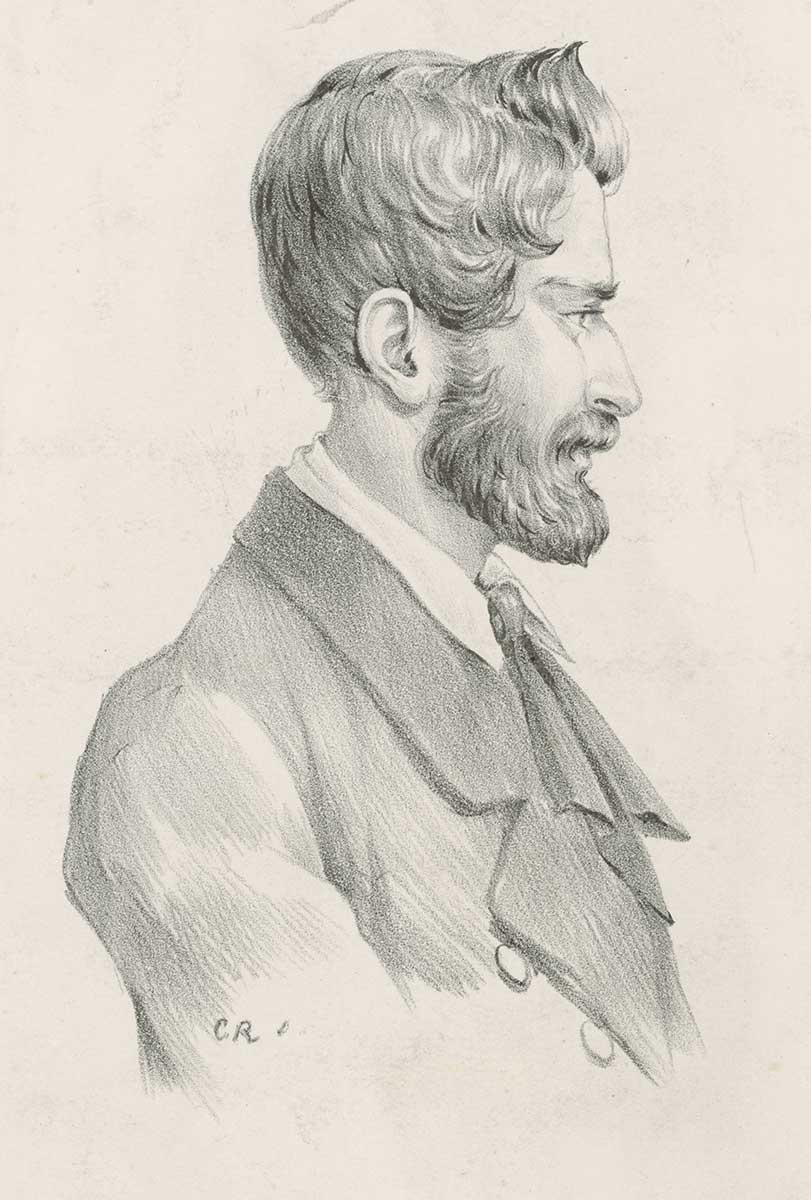
Leichhardt’s place in history
Leichhardt has been officially recognised for his contribution to science, especially for his successful expedition to Port Essington in 1845.
In 1847 the Geographical Society, Paris, awarded its annual prize for geographic discovery equally to Leichhardt and a French explorer.
The Royal Geographical Society in London awarded Leichhardt its Patron's medal, and Prussia also recognised his achievement.
Leichhardt's accounts and collections were valued, and his observations accurate. Some decades after his disappearance, however, harsh criticism of his character was published and his reputation suffered.
The fairness of this criticism has been debated. Nevertheless, his scientific contribution has continued to be recognised and he is remembered today as 'one of the most authoritative early recorders of Australia's environment'. He was the best-trained scientist to explore Australia to that time.
The Leichhardt story is a key one in the annals of Australian inland exploration. His failed attempt to make the first east–west crossing may be compared with the tragic Burke and Wills expedition which, while successful in crossing from south to north, failed to return.
Leichhardt's success in making it to Port Essington in 1845 was a major achievement, and his name deserves to be ranked with Charles Sturt, John McDouall Stuart, Edward John Eyre and other successful explorers.
Twenty-first century Australia continues to commemorate Ludwig Leichhardt. A Queensland river, a Sydney suburb, numerous streets and other places across Australia, as well as a species of tree, bear Leichhardt's name.
- Last updated: 15 June 2007
- 10 programs
In our collection
References
Graeme Aplin et al (eds), Australians: A Historical Dictionary, Sydney, 1987.
Bristow-Smith family, collection of correspondence and newspaper cuttings
David Hallam, The Leichhardt nameplate – a report on authenticity testing (PDF 338kb), National Museum of Australia, Canberra, 2006.
Darrell Lewis, The fate of Leichhardt, Historical Records of Australian Science, vol. 17, pp. 1–30, 2006.
ID MacLeod, 2006, The surface analysis of a brass plate ‘Ludwig Leichhardt 1848’ and assessment of authenticity (PDF 3116kb), Collections Management and Conservation, Western Australian Museum, 2006.
Douglas Pike and John Ritchie (eds), Australian Dictionary of Biography, Melbourne, vol. 2 and vol. 12, 1979 and 1990. See also Renee Erdos, ‘Friedrich Wilhelm Ludwig Leichhardt’, Australian Dictionary of Biography Online Edition.
Colin Roderick, Leichhardt the Dauntless Explorer, Sydney, 1988.
JD Somerville, 'The Leichhardt plate', Proceedings of the Royal Geographical Society of Australasia, South Australian Branch, vol. XXXVII, pp. 37–68, 1937.
EM Webster, Whirlwinds in the Plain: Ludwig Leichhardt – Friends, Foes and History, Melbourne, 1980.
